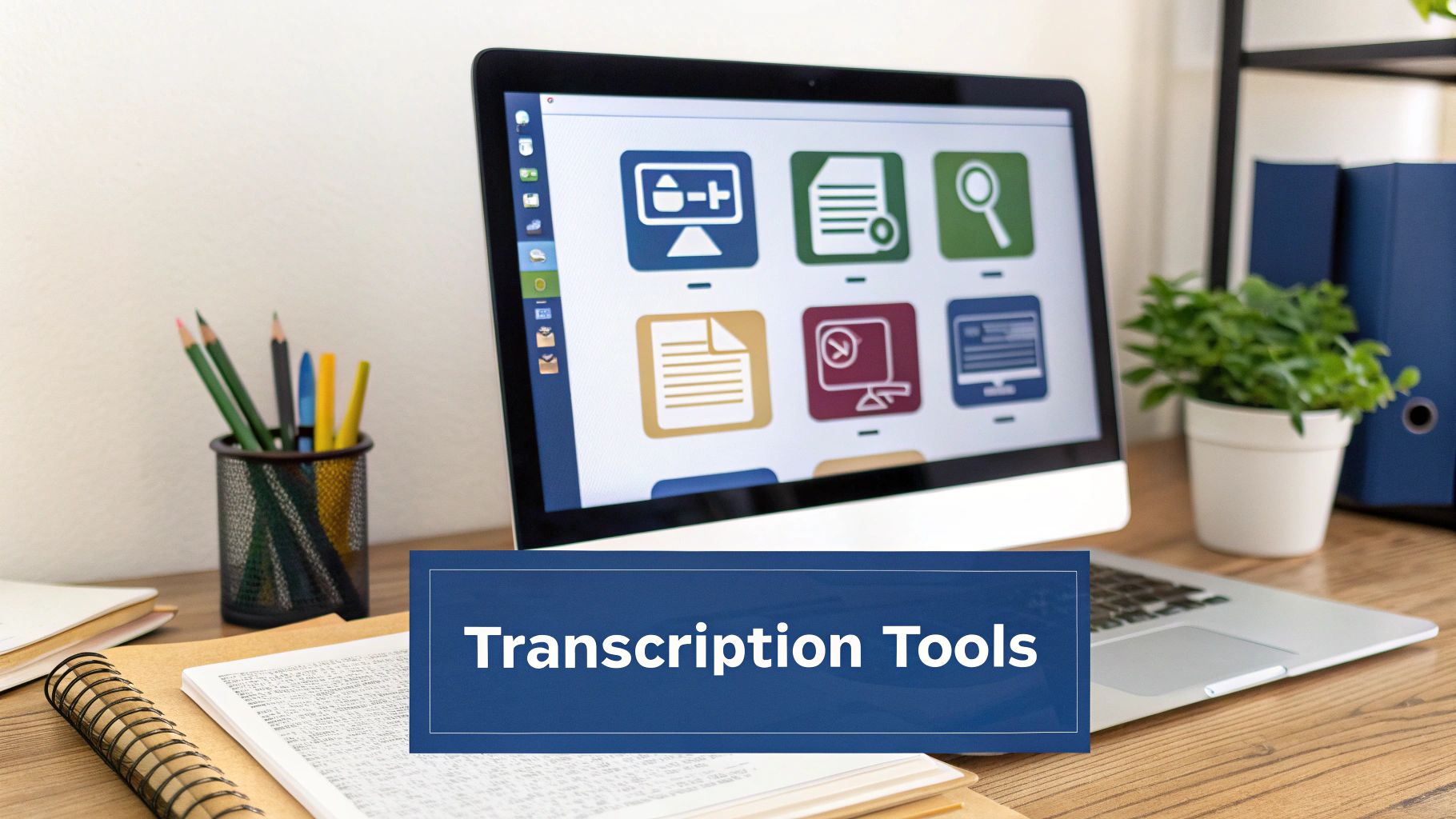How Can I Transcribe an Audio File A Practical Guide
So, you have an audio file and need it in text format. The quickest and most straightforward way is to use an AI-powered service like Whisperit. These tools automatically convert speech to text in just a few minutes, a huge time-saver compared to typing it all out by hand. Just upload your MP3 or WAV file, and the AI handles the heavy lifting, giving you back an editable document.
Understanding Your Transcription Options
When you need to transcribe audio, you’re essentially balancing three things: speed, cost, and accuracy. There's no single "best" method; the right choice really depends on your specific needs. Are you a student trying to get notes from a lecture? A journalist on a tight deadline with an interview? Or a marketer needing perfect subtitles for a video? Knowing your options is the first step.
The demand for turning audio into text is exploding. The global audio transcription software market is projected to hit around $2.5 billion by 2025. This growth isn't surprising when you consider how many fields—from media and education to healthcare—rely on having searchable, accessible text versions of their audio content. You can dig deeper into this trend by checking out recent industry analysis reports.
Manual vs. AI Transcription
At its core, the choice comes down to two main paths: doing it yourself (manual transcription) or letting an AI tool do it for you (automated transcription).
Going the manual route gives you the most control and the highest potential for accuracy, which is great for audio with heavy accents, background noise, or complex jargon. The downside? It’s incredibly time-consuming and can get expensive if you hire someone. On the other hand, AI services deliver results almost instantly and for a fraction of the cost.
This image really highlights the trade-offs:

As you can see, for clear audio, the efficiency you gain with automated transcription is massive, without a significant drop in accuracy.
Pro Tip: There’s also a "hybrid" approach that I find works best for professional results. You start with a fast, AI-generated draft, then have a human editor give it a quick polish. It combines the speed of AI with the nuance of a human touch.
Comparing Transcription Methods
To make the choice even clearer, let's break down the common methods. Each has its place, depending on your budget, timeline, and quality requirements.
| Method | Best For | Average Speed | Typical Accuracy |
|---|---|---|---|
| Manual (DIY) | High-accuracy needs, complex audio, and tight budgets (if you have the time). | 8-10x the audio length (e.g., 8 hours for a 1-hour file). | 99%+ |
| Hired Professional | Mission-critical projects where accuracy is non-negotiable (legal, medical). | 24-48 hours turnaround. | 99.5%+ |
| AI Service | Quick drafts, clear audio, content creation, and general note-taking. | Minutes. | 90%-98% |
Ultimately, for most day-to-day tasks like transcribing meetings, interviews, or lectures, an AI service offers the best balance. It's fast, affordable, and accurate enough to get the job done efficiently.
Get Your Audio Ready for a Perfect Transcription
Before you even drag and drop that audio file, a little prep work can make a world of difference in your final transcript. Seriously, think of it as giving the AI the best possible source material to work with. A clean, high-quality recording is the secret sauce to getting a transcript that's accurate right out of the gate.
It all starts with where you record. We’ve all heard those recordings from a bustling coffee shop or a car with the windows down—it’s a transcription nightmare. Background noise is the enemy. Things like office chatter, traffic, or even a loud fan can easily trip up the AI, leaving you with gaps or nonsensical phrases to fix later.
Choosing the Right Gear and File Type
You don't need a fancy recording studio, but ditching your laptop's built-in mic for a decent external one is a game-changer. It does a much better job of capturing just the speaker's voice and filtering out the distracting ambient noise.
Once your recording is done, the file format you choose is also a key piece of the puzzle. While a standard MP3 is handy, lossless formats are the clear winner for accuracy.
Here's a quick rundown:
- WAV (Waveform Audio File Format): This is the gold standard. It’s uncompressed, meaning every bit of original audio data is preserved, giving the AI the cleanest signal to analyze.
- FLAC (Free Lossless Audio Codec): Think of this as the best of both worlds. FLAC is also lossless, but it cleverly compresses the file size without sacrificing a drop of audio quality.
- MP3 (MPEG Audio Layer III): The most common format, but it's compressed. If you have to use an MP3, make sure it’s saved at a high bitrate—192 kbps or more—to hang onto as much detail as you can.
As you can see below, Whisperit is flexible and accepts a variety of common file types, so you can easily upload your high-quality audio.

This means you can choose what works best for your needs, whether that’s a smaller MP3 for convenience or a crystal-clear WAV for maximum accuracy.
My Two Cents: A pristine audio file is the best way to avoid transcription headaches. Every minute you spend getting a clean recording will save you ten minutes in editing. I’ve learned that the hard way.
If you really want to get into the weeds, our guide on transcribing audio files offers even more tips for audio cleanup. Nailing this first part of the process is what sets you up for a smooth ride all the way to the finish line.
Alright, you've got your audio file prepped and ready to go. Now comes the part where you tell the AI exactly what you need. Think of this as giving your transcriptionist a project brief—a few smart choices upfront can save you a mountain of editing work later.

The settings you choose here will directly shape the quality and usefulness of the final text. Let's walk through the most important options you'll find in a tool like Whisperit.
Fine-Tuning Your Transcription Settings
This is where you give the AI its marching orders. The more specific your instructions, the better the result. Two of the most powerful settings you'll want to pay close attention to are speaker identification and language selection.
Ever tried to read a script from a panel discussion with three different speakers? Without knowing who said what, it's just a confusing wall of text. This is where speaker identification (sometimes called diarization) is a lifesaver. By simply toggling this feature on, Whisperit will automatically label each person's dialogue (e.g., "Speaker 1," "Speaker 2"), turning chaos into a clean, easy-to-follow script.
Language and dialect are just as important. Let's say your audio features a guest speaker from Sydney, but your tool is just set to generic "English." You're bound to get some weird interpretations of slang and pronunciation. Taking a moment to specify "Australian English" tells the AI which phonetic patterns to listen for, which can dramatically boost accuracy.
Key Takeaway: Don't just skip past the settings screen. Taking a few seconds to enable speaker identification and choose the right dialect is a strategic move that turns a decent transcript into a fantastic one that's ready to use right away.
The need for high-quality transcripts is booming. In the United States alone, the general transcription services market is expected to top $32 billion by 2025. This just goes to show how critical it is to get precise, reliable text from audio recordings.
When you master https://www.whisperit.ai/blog/how-to-transcribe-audio-to-text, you're building a genuinely valuable skill. It's also worth checking out the top AI content generation tools to see how automation can help with other tasks beyond transcription. By configuring your project thoughtfully from the get-go, you're making sure the AI works for you, not the other way around.
Taking Your Transcript From Good to Perfect
Alright, the AI has done the heavy lifting, but now it’s time for a little human finesse. This is where you step in. Even the best AI can stumble over industry jargon, similar-sounding words, or moments when everyone starts talking at once. Your job is to take that solid first draft and polish it into something truly professional.
The best place to start is inside an interactive editor. Whisperit synchronizes the audio and text, which is a massive time-saver. You can click on any word in the transcript, and it will immediately play that exact piece of audio. Gone are the days of endlessly scrubbing through a recording to find one tiny mistake. Now you can pinpoint and fix errors in just a few seconds.
Ironing Out Common AI Kinks
AI is incredibly powerful, but it doesn't have the real-world context that you do. As you review the text, keep an eye out for a few common slip-ups:
- Niche Terminology: If your audio is packed with technical terms or company-specific acronyms, the AI might have guessed wrong. This is your chance to correct them.
- Homophones: Words that sound the same but have different meanings—like "their," "there," and "they're"—are classic AI mix-ups.
- Speaker Mix-ups: When multiple people are talking, especially if they're interrupting each other, the AI can sometimes get confused about who said what.
Think about cleaning up a transcript from a chaotic team meeting. You'd use the speaker labels to ensure every idea is attributed to the right person, which is critical for accurate meeting minutes. For really refining your text on a sentence-by-sentence basis, looking into line editing techniques can help make the final document read beautifully.
You can see how easy it is to make these fixes in Whisperit's editor in the screenshot below.
The way it connects the text directly to the audio makes the whole editing process feel intuitive and fast.
A great transcript is more than just accurate words; it’s about capturing the right meaning and context. A quick human review is the only way to guarantee you’ve preserved the real intent behind the conversation.
This final check is absolutely essential for creating a transcript you can rely on. If you're looking for more foundational advice, our guide on transcription tips for beginners is a great place to start. Spending just a few minutes on this review can elevate the final result from simply usable to genuinely professional.
Putting Your Final Transcript to Work

You’ve done the hard part—your transcript is polished and ready. But the real magic happens when you put that text to use. Exporting your transcript in the right format is the critical final step that transforms raw text into a powerful, multi-purpose asset.
Think about your final goal. Are you creating subtitles for a new marketing video destined for YouTube? You’ll need a file with precise timestamps. Or maybe you're drafting a blog post from a recent interview? In that case, a simple text document you can easily edit is all you need.
Choosing the Right Export Format
Whisperit gives you a few different export options, and each one is built for a specific job. Picking the right one from the get-go saves a ton of headaches and makes sure the transcript plugs right into whatever you're doing next.
Here’s a quick breakdown of what you can export from Whisperit and where each format really shines.
Whisperit Export Options and Use Cases
| File Format | Common Use Case | Key Feature |
|---|---|---|
| SRT | Video subtitles and closed captions | Contains precise timestamps that sync the text perfectly with your video. |
| DOCX | Reports, articles, and formal documents | Opens and edits flawlessly in word processors like Microsoft Word or Google Docs. |
| TXT | Raw text for notes or content repurposing | A universal, no-frills format for simple text editing or importing into other apps. |
So, a podcaster might pull an SRT file for their video version on YouTube, then grab a TXT file to quickly generate show notes or a full blog post. It's all about getting the most mileage out of a single recording.
Pro Tip: By strategically choosing your export format, you can turn a single audio file into multiple pieces of content—from social media clips and audiograms to in-depth articles and email newsletters.
This final step is about making your content work smarter, not harder. Of course, for sensitive audio in fields like healthcare or legal, security is paramount. It’s always a good idea to brush up on HIPAA-compliant transcription to keep your workflows secure and compliant.
Common Questions About Audio Transcription
When you're new to transcribing audio, a few questions always seem to pop up. Getting these sorted out early on can save you a ton of headaches and make sure your projects run smoothly.
Let's start with the big one: accuracy. Just how good is AI compared to a human? Modern transcription tools can hit up to 99% accuracy on a crystal-clear recording. But the real world is messy. Things like background noise, thick accents, or people talking over each other will definitely bring that number down. AI is incredibly fast, but for catching those subtle mistakes, a quick human review is still your best bet.
Handling Specific Audio Scenarios
Another thing people often wonder about is file format. If you're chasing absolute perfection, use a lossless format like WAV or FLAC. They keep every bit of the original audio data. That said, for most everyday projects, a high-quality MP3 (at least 192 kbps) is perfectly fine and won't eat up all your storage space.
What if you're transcribing a podcast or a team meeting with multiple people? This is where speaker identification becomes a lifesaver. Good transcription platforms can automatically figure out who is talking and label their lines, making the final transcript so much easier to read.
The technology is getting better every day. The AI transcription market is already a $4.5 billion** industry in 2024 and is on track to hit **$19.2 billion by 2034. This boom is happening because AI is getting smarter at understanding different dialects and even industry-specific jargon. You can dig into the numbers in a recent market analysis.
For specialized fields like healthcare, there’s no room for error. Using an AI that understands complex medical terms is absolutely critical for creating accurate and reliable documentation.
If you work in a niche field, you'll need a tool that can keep up with your specific vocabulary. For anyone in the medical profession, our complete guide to medical transcription training is a great resource for learning how to meet those high-stakes accuracy demands.
Ready to turn your audio into clean, searchable text? Give Whisperit a try and see how our AI can get the job done in minutes. https://whisperit.ai